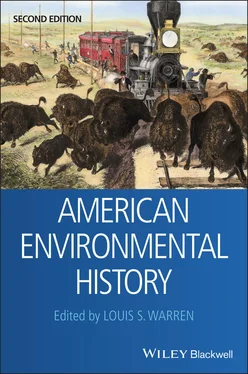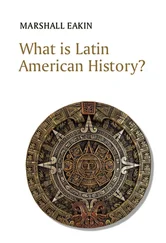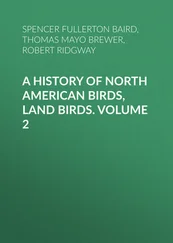Anthropogenic Tropical Rain Forest
The tropical rain forest has long had a reputation for being pristine, whether in 1492 or 1992. There is, however, increasing evidence that the forests of Amazonia and elsewhere are largely anthropogenic in form and composition. Sauer (1958, 105) said as much at the Ninth Pacific Science Congress in 1957 when he challenged the statement of tropical botanist Paul Richards that, until recently, the tropical forests have been largely uninhabited, and that prehistoric people had “no more influence on the vegetation than any of the other animal inhabitants.” Sauer countered that Indian burning, swiddens, and manipulation of composition had extensively modified the tropical forest.
“Indeed, in much of Amazonia, it is difficult to find soils that are not studded with charcoal” (Uhl et al. 1990, 30)….
The Amazon forest is a mosaic of different ages, structure, and composition resulting from local habitat conditions and disturbance dynamics (Haffer 1991). Natural disturbances (tree falls, landslides, river activity) have been considerably augmented by human activity, particularly by shifting cultivation. Even a small number of swidden farmers can have a widespread impact in a relatively short period of time....
Indian modification of tropical forests is not limited to clearing and burning. Large expanses of Latin American forests are humanized forests in which the kinds, numbers, and distributions of useful species are managed by human populations.
…There are no virgin tropical forests today, nor were there in 1492.
The indigenous impact on wildlife is equivocal. The thesis that “over-kill” hunting caused the extinction of some large mammals in North America during the late Pleistocene, as well as subsequent local and regional depletions (Martin 1978, 167–72), remains controversial. By the time of the arrival of Cortéz in 1519, the dense populations of Central Mexico apparently had greatly reduced the number of large game, given reports that “they eat any living thing” (Cook and Borah 1971–79, (3) 135, 140). In Amazonia, local game depletion apparently increases with village size and duration (Good 1987). Hunting procedures in many regions seem, however, to have allowed for recovery because of the “resting” of hunting zones intentionally or as a result of shifting of village sites.
On the other hand, forest disturbance increased herbaceous forage and edge effect, and hence the numbers of some animals (Thompson and Smith 1970, 261–64). “Indians created ideal habitats for a host of wildlife species … exactly those species whose abundance so impressed English colonists: elk, deer, beaver, hare, porcupine, turkey, quail, ruffed grouse, and so on” (Cronon 1983, 51). White-tailed deer, peccary, birds, and other game increases in swiddens and fallows in Yucatán and Panama (Bennett 1968; Gordon 1982, 96–112; Greenberg 1991). Rostlund (1960, 407) believed that the creation of grassy openings east of the Mississippi extended the range of the bison, whose numbers increased with Indian depopulation and reduced hunting pressure between 1540 and 1700, and subsequently declined under White pressure.
Agriculture
Fields and Associated Features
To observers in the sixteenth century, the most visible manifestation of the Native American landscape must have been the cultivated fields, which were concentrated around villages and houses. Most fields are ephemeral, their presence quickly erased when farmers migrate or die, but there are many eye-witness accounts of the great extent of Indian fields. On Hispaniola, Las Casas and Oviedo reported individual fields with thousands of montones (Sturtevant 1961, 73). These were manioc and sweet potato mounds 3–4 m in circumference, of which apparently none have survived. In the Llanos de Mojos in Bolivia, the first explorers mentioned percheles , or corn cribs on pilings, numbering up to 700 in a single field, each holding 30–45 bushels of food (Denevan 1966, 98). In northern Florida in 1539, Hernando de Soto’s army passed through numerous fields of maize, beans, and squash, their main source of provisions; in one sector, “great fields … were spread out as far as the eye could see across two leagues of the plain” (Garcilaso de la Vega 1980, (2) 182; also see Dobyns 1983, 135–46).
It is difficult to obtain a reliable overview from such descriptions. Aside from possible exaggeration, Europeans tended not to write about field size, production, or technology. More useful are various forms of relict fields and field features that persist for centuries and can still be recognized, measured, and excavated today. These extant features, including terraces, irrigation works, raised fields, sunken fields, drainage ditches, dams, reservoirs, diversion walls, and field borders number in the millions and are distributed throughout the Americas (Denevan 1980; see also Doolittle 1992; Whitmore and Turner 1992). For example, about 500,000 ha of abandoned raised fields survive in the San Jorge Basin of northern Colombia (Plazas and Falchetti 1987, 485), and at least 600,000 ha of terracing, mostly of prehistoric origin, occur in the Peruvian Andes (Denevan 1988, 20). There are 19,000 ha of visible raised fields in just the sustaining area of Tiwanaku at Lake Titicaca (Kolata 1991, 109) and there were about 12,000 ha of chinampas (raised fields) around the Aztec capital of Tenochtitlán (Sanders et al. 1979, 390). Complex canal systems on the north coast of Peru and in the Salt River Valley in Arizona irrigated more land in prehistory than is cultivated today. About 175 sites of Indian garden beds, up to several hundred acres each, have been reported in Wisconsin (Gartner 1992). These various remnant fields probably represent less than 25 percent of what once existed, most being buried under sediment or destroyed by erosion, urbanization, plowing, and bulldozing. On the other hand, an inadequate effort has been made to search for ancient fields.
The size of native populations, associated deforestation, and prolonged intensive agriculture led to severe land degradation in some regions. Such a landscape was that of Central Mexico, where by 1519 food production pressures may have brought the Aztec civilization to the verge of collapse even without Spanish intervention (Cook and Borah 1971–79 (3), 129–76). There is good evidence that severe soil erosion was already widespread, rather than just the result of subsequent European plowing, livestock, and deforestation. Cook examined the association between erosional severity (gullies, barrancas, sand and silt deposits, and sheet erosion) and pre-Spanish population density or proximity to prehistoric Indian towns. He concluded that “an important cycle of erosion and deposition therefore accompanied intensive land use by huge primitive populations in central Mexico, and had gone far toward the devastation of the country before the white man arrived” (Cook 1949, 86).
Barbara Williams (1972, 618) describes widespread tepetate , an indurated substrate formation exposed by sheet erosion resulting from prehistoric agriculture, as “one of the dominant surface materials in the Valley of Mexico.” On the other hand, anthropologist Melville (1990) argues that soil erosion in the Valle de Mezquital, just north of the Valley of Mexico, was the result of overgrazing by Spanish livestock starting before 1600: “there is an almost total lack of evidence of environmental degradation before the last three decades of the sixteenth century.” The Butzers, however, in an examination of Spanish land grants, grazing patterns, and soil and vegetation ecology, found that there was only light intrusion of Spanish livestock (sheep and cattle were moved frequently) into the southeastern Bajío near Mezquital until after 1590 and that any degradation in 1590 was “as much a matter of long-term Indian land use as it was of Spanish intrusion” (Butzer and Butzer 1993). The relative roles of Indian and early Spanish impacts in Mexico still need resolution; both were clearly significant but varied in time and place. Under the Spaniards, however, even with a greatly reduced population, the landscape in Mexico generally did not recover due to accelerating impacts from introduced sheep and cattle.
Читать дальше











